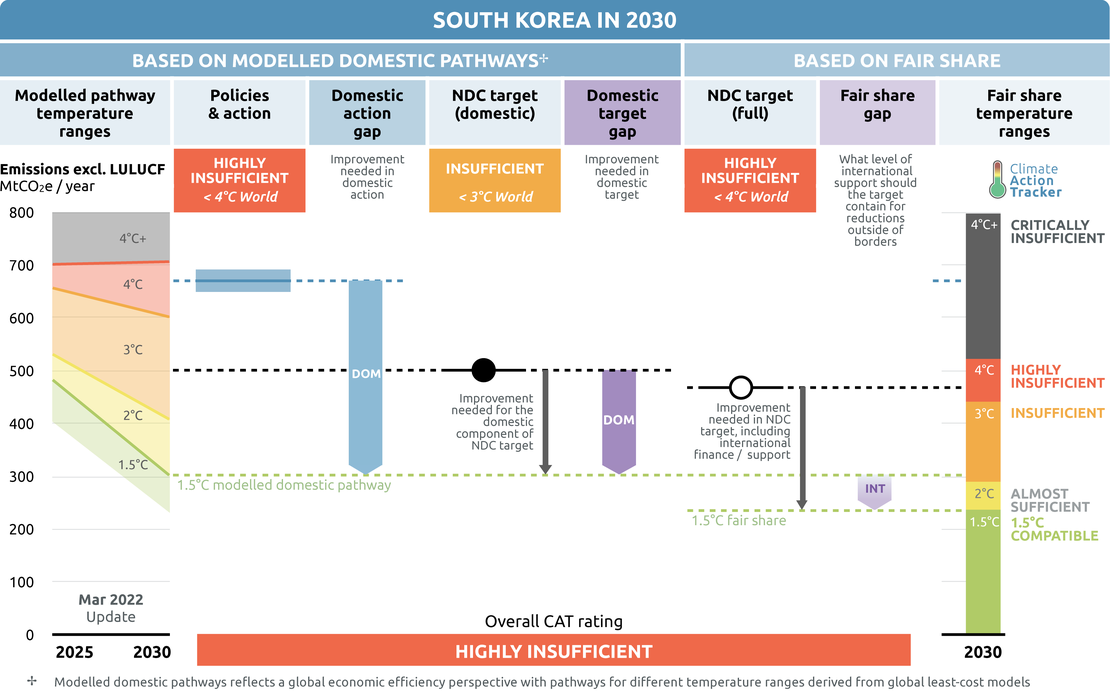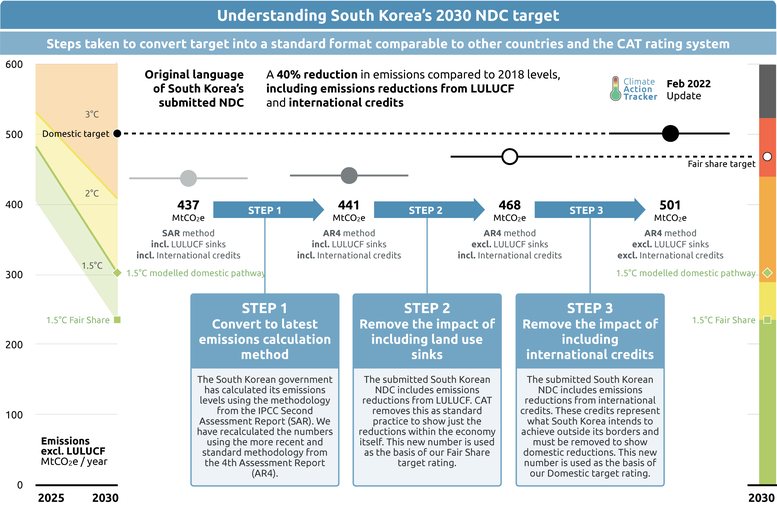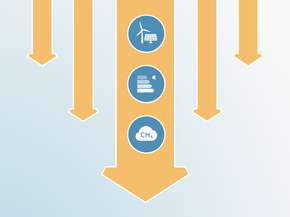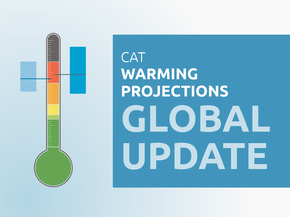Targets
Paris Agreement targets
NDC description
South Korea announced a stronger NDC in October 2021 – a 40% reduction in emissions compared to 2018 levels, including emissions reductions from LULUCF and international credits (Republic of Korea, 2021a). This target was submitted to the UNFCCC in December 2021 (Republic of Korea, 2021e).
The absolute emissions target communicated by the government is 437 MtCO2e, using global warming potentials (GWPs) from the IPCC’s second assessment report (SAR). To ease comparison of country targets we convert to GWPs from the IPCC’s fourth assessment report (AR4) (see assumptions section). We estimate that the absolute emissions target in AR4 is 441 MtCO2e.
The CAT estimates the domestic target as 501 MtCO2e (excl. reductions from LULUCF and international credits) and the fair share target as 468 MtCO2e (excl. reductions from LULUCF, incl. international credits), representing an 18% reduction compared to the NDC submitted in December 2020 (see assumptions section). The conversion of South Korea’s NDC to the CAT fair share and domestic targets is shown in the figure below.
The new NDC improves the CAT fair share target rating from “Critically Insufficient” to “Highly Insufficient”, while the domestic target rating remains “Insufficient”. To meet the Paris Agreement’s 1.5oC temperature limit, the CAT estimates that a domestic reduction of at least 59% is needed by 2030 (302 MtCO2e).
South Korea plans to achieve part of its 2030 target through purchasing international credits and increasing the LULUCF sink. Compared to the 2020 NDC update, the new NDC increases the LULUCF sink from -22.1 to -26.7 MtCO2e and the overseas reductions from -16.2 to -33.5 MtCO2e. Reductions from carbon capture, utilisation, and storage (CCUS) remains unchanged at -10.3 MtCO2e (Republic of Korea, 2021b).
In its updated NDC from 2020, South Korea provided information to facilitate clarity, transparency and understanding of the mitigation target, as per Decision 4/CMA.1. Most importantly, by setting an absolute target, South Korea made it easier to understand the meaning of its NDC. Further, in an Annex, the government provides clear information on timeframes, scope and coverage, planning processes, and other aspects of the 2030 target.
The CAT rates South Korea’s domestic target as “Insufficient” and its fair share target as “Highly insufficient”.
We rate South Korea’s domestic target for 2030 as “Insufficient” when compared modelled domestic pathways. The “Insufficient” rating indicates that South Korea’s domestic target in 2030 needs substantial improvements to be consistent with the 1.5°C temperature limit. If all countries were to follow South Korea’s approach, warming would reach over 2°C and up to 3°C.
We rate South Korea’s overall NDC target (including the domestic and the international element) as “Highly insufficient” when compared with its fair-share contribution to climate action. The “Highly insufficient” rating indicates that South Korea’s fair share target in 2030 leads to rising, rather than falling, emissions and is not in line with any interpretation of a fair approach to meeting the 1.5°C limit. If all countries were to follow South Korea’s approach, warming could reach over 3°C and up to 4°C.
Further information on how the CAT rates countries (against modelled pathways and fair share) can be found here.
Last NDC update
South Korea submitted its updated NDC in December 2021, strengthening the nation’s 2030 target from 24.4% below 2017 levels to 40% below 2018 levels, including reductions from LULUCF and international credits. In absolute terms, the CAT estimates the new NDC reduces South Korea’s fair share target (excl. LULUCF, incl. international credits) from 563 to 468 MtCO2e and its domestic target (excl. LULUCF and international credits) from 579 to 501 MtCO2e (32% reduction below 2018 levels).

Net zero and other long-term target(s)
We evaluate the net zero target as: Average.
After President Moon Jae-in announced South Korea’s goal of becoming carbon neutral by 2050, the government also included this commitment in its updated NDC and its Long-Term Strategy (Republic of Korea, 2020b, 2021a). The carbon neutrality target is enshrined in law through the Carbon Neutrality Act, which was passed in August 2021 (Ministry of Environment, 2021).
In October 2021, South Korea published the 2050 carbon neutrality scenarios with two pathways to net zero emissions in 2050 (Republic of Korea, 2021c). Both scenarios lead to a coal phase out before 2050 but remain unclear about the exact phase out year. One of the scenarios maintains a share of natural gas, while the other one phases out gas by 2050 as well. Improving on the LTS, the 2050 carbon neutrality scenarios explicitly states that the net zero target does not include overseas reductions. South Korea is still not explicit in its coverage of GHGs, and the target review process lacks detail.
2020 pledge
Under the Copenhagen Accord, South Korea agreed to reduce its emissions by 30% below business-as-usual (BAU) emissions by 2020. It proposed this unconditional target in November 2009 and submitted it to the Copenhagen Accord on 25 January 2010. Under the BAU projections from the Third National Communication, the 2020 pledge would have resulted in emissions of 551 MtCO2e/year excluding LULUCF (equivalent to 85% above 1990 emission levels). Emissions in 2020 exceeded this target by around 25% at 687 MtCO2e excluding LULUCF.
Further analysis
Latest publications
Stay informed
Subscribe to our newsletter






